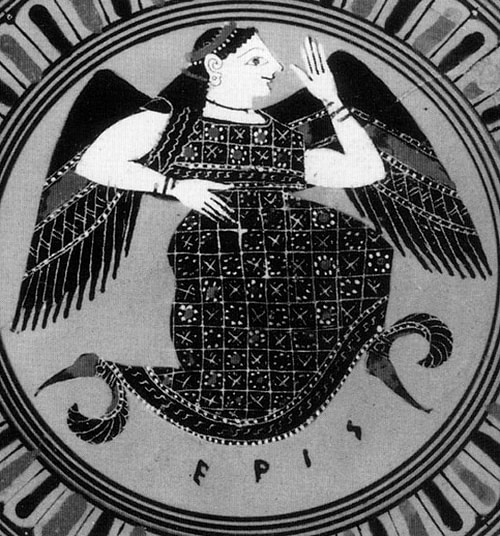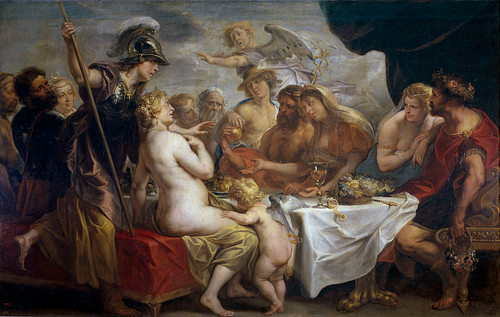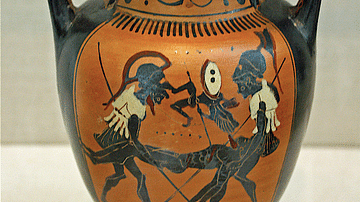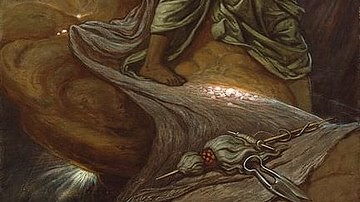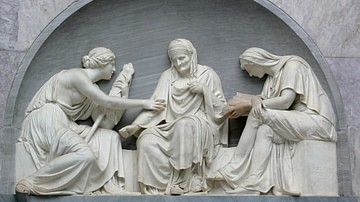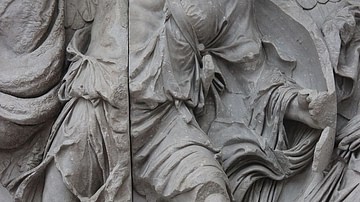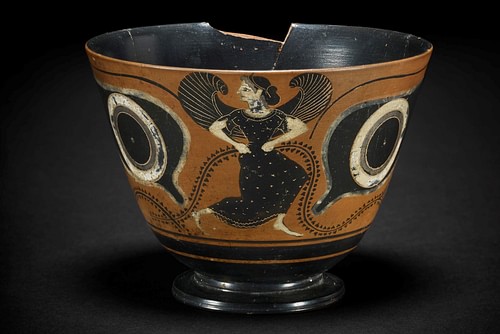
Eris is the Greek goddess and personification of discord and strife. She is an unpopular figure in Greek mythology due to her problematic behaviour and her ability to stir up trouble wherever she goes. Eris is most famous for her Golden Apple of Discord, which played a key role in the cause of the Trojan War.
Eris is the daughter of Nyx, or Zeus and Hera, and the sister of Ares, the Greek god of war, who she often accompanied into battle, riding alongside him in his chariot.
Birth & Family
In the Iliad, Homer (c. 750 BCE) mentions her as being the sister of Ares, making her the child of Zeus and Hera. However, according to most sources, including Hesiod's (c. 700 BCE) Theogony, Eris was the last-born child of Nyx (the personification of the night). Eris gave birth to many children of her own, who all represented dark and harmful things that could arise from discord and conflict:
And hateful strife gave birth to wretched Work,
Forgetfulness, and Famine, tearful Pains,
Battles and Fights, Murders, Killings of men,
Quarrels and Lies and Stories and Disputes,
And Oath, who brings most grief to men on earth
When anyone swears falsely, knowing it.(Hesiod, Theogony, 225-230)
Nature & Appearance
Throughout Greek mythology, Eris is portrayed as a mean figure and a troublemaker. She is avoided by many of her fellow gods and goddesses. The only god who can tolerate her is her brother Ares, who often rides into battle with her and rejoices in the horrors of war alongside her. In the Iliad, Homer mentions that she often strides across the earth, spreading hate against both the Trojan and Greek armies. Unlike Ares, who eventually sided with the Trojans, Eris never took a side during the Trojan War. In Book 11, Zeus sent Eris to Odysseus' ship, where she cried out in her terrible and great voice, raising the fighting spirit in each Greek soldier's heart and effectively stopping them from sailing back home. At one point in the Iliad, Eris is the only one of the gods who stays on the battlefield to watch the battle, exalting in the bloodshed and entirely in her element.
Hesiod presents an alternative Eris in his Works and Days, which is believed to be written after his Theogony. In Works and Days, Hesiod suggests that there are two of Eris; the younger and secondary Eris is horrible towards humans and causes problems for them, while the main Eris is older and a force for good, instilling a sense of competition in humankind instead of strife.
Strife is no only child. Upon the earth
Two strifes exist; the one is praised by those
Who come to know her, and the other blamed.
Their natures differ: for the cruel one a
Makes battles thrive, and war; she wins no love
But men are forced, by the immortals' will,
To pay the grievous goddess due respect.
The other, first-born child of blackest Night,
Was set by Zeus, who lives in air, on high,
Set in the roots of earth, an aid to men.
She urges even lazy men to work.(Hesiod, Works and Days, 120-130)
Eris is very rarely depicted in ancient art. However, the Greek author and geographer Pausanias (c. 115 to c. 180 CE) wrote that he saw a beautifully decorated chest that showed an ugly Eris standing between two warriors. She is also alternatively depicted as a winged female figure.
Eris & the Apple of Discord
The most famous myth involving Eris is the Judgement of Paris, which is the inception of the Trojan War. The tale begins with the wedding of Peleus, the Greek hero and king of Phthia, and Thetis, a sea nymph, on Mount Pelion. The guests at the wedding included the Olympians, who gifted the couple with a suit of golden armour and the immortal horses Balius and Xanthus. One noticeable absence was Eris, who was often left out of events due to her troublesome nature. Feeling angry over being left out, Eris decided to stir up mischief by causing conflict among the Olympians.
While Athena, Hera, and Aphrodite were chatting arm in arm, Eris rolled her Golden Apple of Discord towards their feet. The apple bore the words "to the fairest." Not knowing who the apple was addressed to, the three goddesses all claimed the apple and began to cause a scene. Zeus quickly acted as a mediator and ordered the goddesses to present themselves before Paris, a prince of Troy.
Paris awoke from a nap to find the god Hermes standing before him. Hermes presented Athena, Hera, and Aphrodite to Paris and asked him to choose which goddess was the fairest. Each goddess offered Paris a gift in return for his vote. Hera offered him dominion over the world, Athena offered him the glory of war, and Aphrodite promised Paris the most beautiful woman in the world (Helen of Sparta). Not being able to resist Aphrodite's offer, Paris selected her as the fairest goddess. So began his pursuit of the already-married Helen of Sparta and the beginning of the Trojan War.
Other Myths
Eris is also featured in the myth of the artist Polytechnos and his wife, Aëdon. As mentioned in the Ornithogonia by the Greek grammarian Boios, Polytechnos and Aëdon lived a prosperous life with their son, Itys. However, one day they foolishly began to boast that their love was greater than that of Zeus and Hera. An irate Hera sent Eris as their punishment. Eris did what she did best and stirred up conflict and competition between the couple. This resulted in tragedy as Aëdon killed their son, Itys, and fed him to her husband. Upon finding out what he had eaten, Polytechnos pursued Aëdon but was captured in the process, covered in honey and thrown into a meadow. Aëdon felt sympathy for her husband and went to rescue him. However, her family turned on her and attempted to kill her before Zeus intervened and turned the whole family into different birds to avoid further tragedy.
Another wedding that involved the meddlesome Eris was the wedding of Pirithous, king of the Lapiths, and Hippodamia. Once again, all the Olympians were invited, except for Eris, as everyone remembered the trouble she had stirred up at the wedding of Peleus and Thetis. Sure enough, Eris still found a way to make her mark. The centaurs, not used to the strength of wine, drank their fill, and as soon as the bride entered the cavern, the centaur Eurytion lunged at her and dragged her away. Pirithous ran to Hippodamia's rescue, cut off Eurytion's nose and ears, and threw him out of the cavern. This started a fight between the Lapiths and centaurs and was the beginning of a long feud – engineered by Eris and Ares.
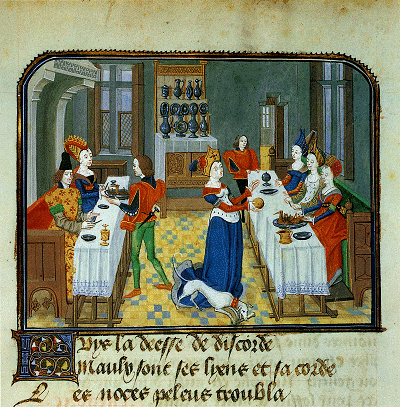
Eris appears in a myth involving Atreus, king of Mycenae and the father of Agamemnon and Menelaus. Atreus claimed the throne of Mycenae by right of primogeniture and as the owner of the lamb with a golden fleece, which had been created by Hermes' friend Pan. Atreus sacrificed the lamb to Artemis as it had been foretold. However, his rule was challenged by his twin brother, Thyestes, who contested the lamb's ownership and claimed Mycenae's throne. Zeus favoured Atreus and asked Hermes to interfere. Hermes went to Atreus and told him to ask Thyestes if he would give up the crown if the sun moved backwards on the dial. Thyestes agreed, and Zeus enlisted the help of Eris to reverse the laws of nature, and Atreus was restored to the throne, banishing his brother from Mycenae.
Legacy & Discordianism
Although Eris is not featured in many Greek myths, the largest dwarf planet is named after her. It orbits the sun just beyond the Kuiper Belt, and it is the farthest object known to man that orbits the sun (besides comets). It has one moon called Dysnomia. Eris, the wedding of Peleus and Thetis, and her Apple of Discord are also the inspiration behind the fairy tale Sleeping Beauty in which a wicked fairy is not invited to the princesses' christening and places a curse on her as punishment.
A modern religion called Discordianism, dedicated to Eris, was established in 1957 by Gregory Hill (Malaclypse the Younger) and Kerry Wendell Thornley (Omar Khayyam Ravenhurst). The teachings of Discordianism revolve around Greek mythology, the analysation of conspiracy theories and a form of modern paganism that is goddess focused. The religion has grown over the years through word of mouth, role-playing clubs, the internet and the underground publishing industry. Its primary holy scripture is the Principia Discordia, written mainly by Gregory Hill. It describes how the religion began with a vision of Eris, who showed them a yin-yang-like symbol with the Apple of Discord on one side and a pentagon on the other. It tells the story of how humanity fell from grace due to the Original Snub (the wedding of Peleus and Thetis). The Apple of Discord established the Discordian Mysteries, including the Law of Fives, which teaches that all the events in the universe revolve around the number five. It involves the Five Commandments, the Five Apostles of Eris, and the Five-Fingered Hand of Eris, which guides all of humankind's chaotic decisions and movements.
